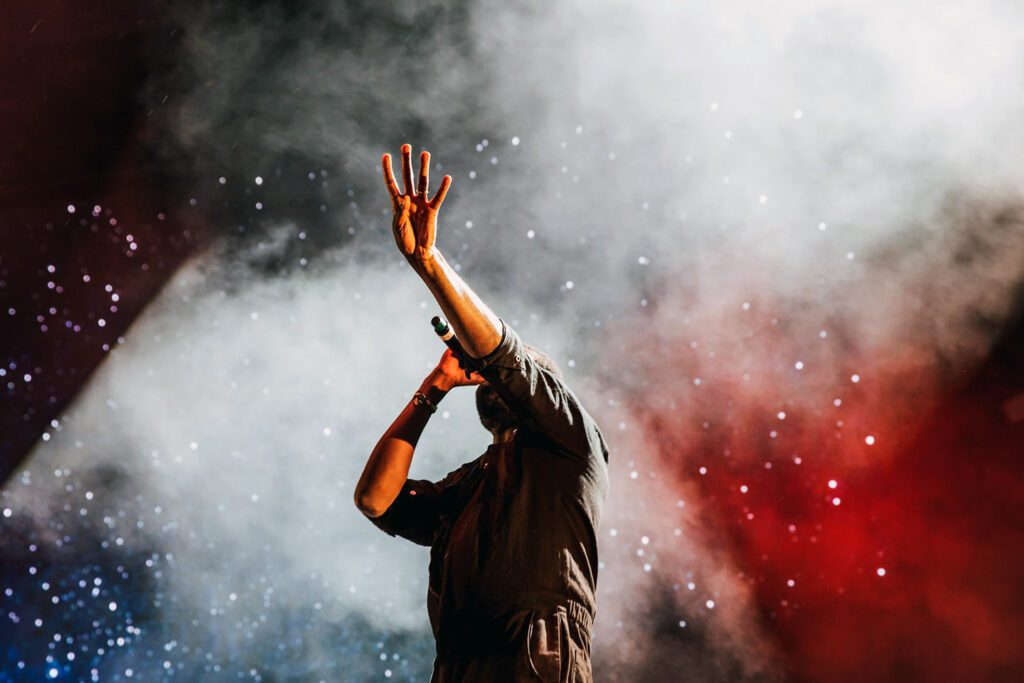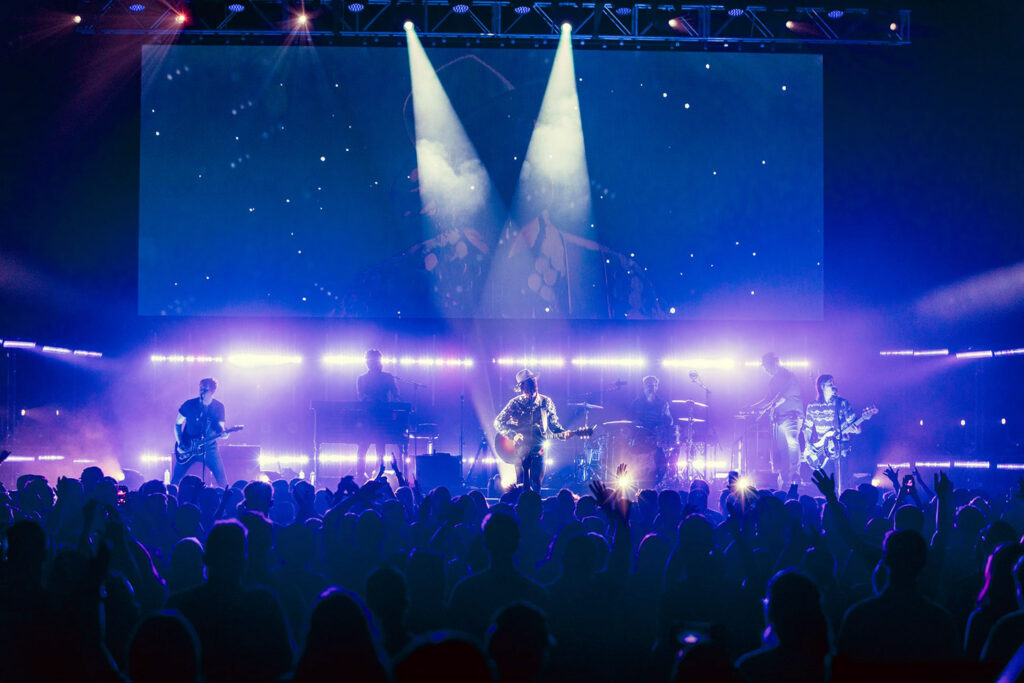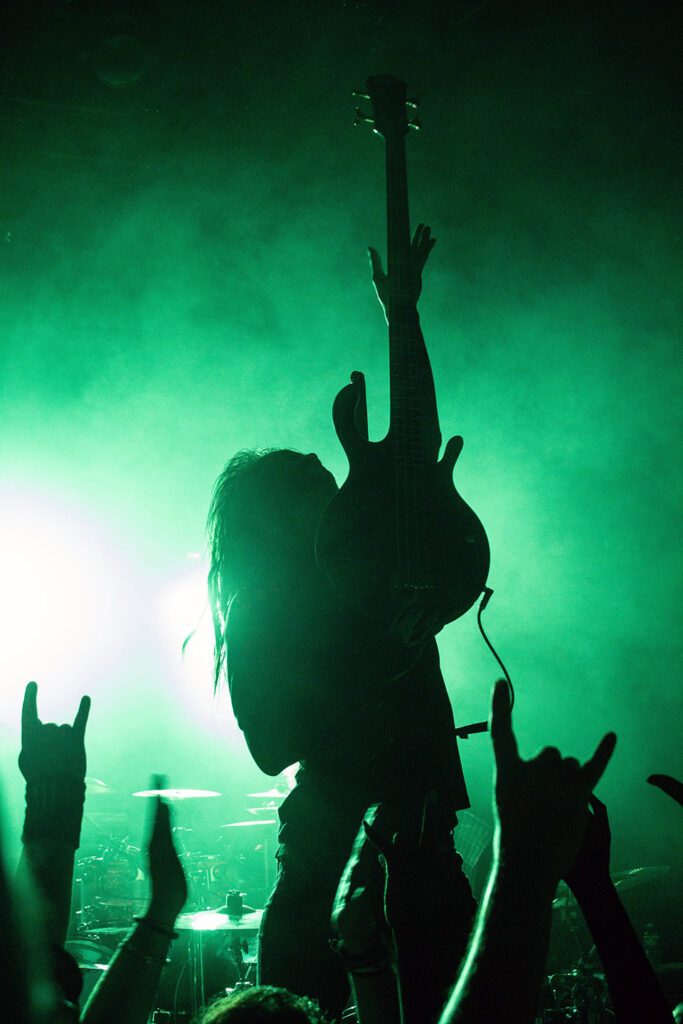An 85mm lens is an ideal focal length for concert photography because it gives you a good mix of nice compression and perspective on your shots depending on how far you’re standing from the stage. It’s ideal for photographing musicians on stage, as well as capturing the energy of their performance.
85mm Lens Pros and Cons

An 85mm lens, be it from Canon, Nikon or Sony is a great choice for concert photography because it captures the subject in nice detail while still giving you some room to shoot from an angle that’s interesting.
The Pros
- It is excellent for close-up shots
It can greatly capture each band member in detail, like their emotions and expressions. You can isolate your favorite artist by focusing on him/her, which can be a great way to capture his personality.
It can also be used to take their portraits and with the use of a wide aperture, you can achieve a shallow depth-of-field and blur the background.
- An 85mm lens is best for compressing backgrounds and producing creamy bokeh
An 85mm lens can isolate your subject from the background and give you a nice bokeh effect on a full-frame camera.
In order to achieve this, you need to use a wide or fast aperture such as f/1.8 or f/2.8. This allows you to capture a blurred background and creamy bokeh which is ideal for portraits.
Bokeh is the aesthetic quality of the blur produced in the out-of-focus parts of an image produced by a lens. Depending on the type, it can be described as smooth/creamy or harsh/busy.
It is most visible around small highlights, such as specular reflections (e.g., light sources) and bright points of light sited within the depth of field of an image; when these are rendered as circles rather than discs, it may create a stylized rendering that draws attention to those elements within your composition.
- It has enough reach for capturing concerts
An 85mm lens can be flexible when shooting concerts. If you’re far from the stage, it can even capture the whole stage, which is also important in concert photography.
If you’re just standing near the stage, it can be used for close-ups or headshots.

The Cons
- They are not the most affordable
In general, 85mm lenses can be pretty expensive. However, there are some older 85mm lenses that can be found for a reasonable price such as the Canon EF 85mm f/1.8 and Nikon 85mm f/1.8D. These lenses are more than enough for most amateurs.
However, once you stepped up to f/1.4s and f/1.2s, you’re looking at spending a lot more money. These lenses have better image quality, build quality, and performance than their slower counterparts.
The Canon EF 85mm f/1.2L II and Nikon 85mm f/1.4G are both superior and they are popular choices among professional photographers.
When you’re looking at the price tag of these lenses, remember that this is a one-time expense; there’s no need to buy another lens once you get one of these!
- Can be hard to use as your only lens
This is a common problem with lenses that are too wide or too long. It’s easy to get yourself into trouble by using one of these lenses as your only lens.
If you’re going to a concert, it’s best to bring at least two different lenses along with you—one for close-ups and one for shooting wide.
Is an 85mm Lens Worth It?

85mm lens is a great lens for portraits and its focal length is quite useful for shooting concerts. And because most of these lenses have faster apertures, they can compress the background and create beautiful bokeh.
With that being said, even if you get the cheapest 85mm prime lens on the market, you will still get your money’s worth.
What Lenses Are Best for Concert Photography?
Here are a few lenses that I can recommend for concert photography:

35mm f/1.8 or 50mm f/1.8 – These lenses are the best for shooting concerts up close. They’re small, lightweight, and have a fast aperture that lets you shoot well in low-light situations.
85mm f/1.8 – This lens is perfect for portraits and concerts. It’s one of the best lenses because it has a fast aperture that lets you shoot in low-light situations, while also giving you enough room to get up close to your subject without being intrusive.

24-70mm f/2.8 – If you can bring only one lens to a concert, this is it! It’s a great all-around lens for shooting concerts. It has a wide range of focal lengths so you can get close to the action without being too invasive. You can also use it to capture wide shots of the entire stage.

Ultra-wide fisheye lenses – There are a lot of them in the market ranging from 8mm – 16mm. These lenses have a fisheye effect that can really bring out a unique look.
They are fun to use and can be very creative. While they are not my first choice for shooting live concerts, they can also be great for other genres like landscapes and interiors.
How Do You Photograph A Concert?
Shooting concerts can be a challenge because you have to keep up with the action, get your settings right, and capture the shot just at the right moment. Here are some tips to help you get started:
- Find a good spot to stand or sit.
- Bring at least two lenses with you. A wide-angle and a telephoto. A zoom lens with a 28-70mm range will work great as well.
- Listen for when the band or artist you want to shoot starts playing their own music. This is usually during the first song of an opening act’s set.
- Take some time to get familiar with the stage layout, lighting, and sound system so that you can anticipate where people will be moving around during the performance.
- Get some wide shots of the stage, crowd, and overall venue so that you have something to fall back on if you don’t get any good shots during the performance itself.
- Try not to use flash during concerts since it can be distracting for those in attendance and for the performers. Using a flash or a speedlight is also prohibited in most concerts.
- Don’t just take photos, enjoy the music and have fun. If you’re not having fun, then you’re doing it wrong.
What settings should I use for concert photography?
- Shoot in RAW (jpegs if you don’t have the time to edit them).
- Set your white balance to auto.
- Set your ISO between 800 to 3200.
- Set your camera to manual exposure.
- If you taking a lot of photos, set your camera to shutter priority.
- Set your shutter speed around 1/200th or higher.
- If you’re shooting in manual, set your aperture around f/1.4 or f/4.
- Set the shooting mode to continuous mode and choose a burst rate around 5-11 FPS.

The settings above are just a general guideline. You can modify these settings to suit your needs. And always remember that you can’t use your built-in flash or any external light source when shooting a concert unless you’re permitted to.
How Do I Make My Concert Pictures Sharper?
If you’re finding your photos came out soft and blurry, it could be because of your shutter speed. You should set your shutter speed to 1/200th or higher to freeze the moment. Aperture can also play a huge role in making your photos sharp.
A fast aperture will let in more light, and it will help to increase your shutter speed. But it can also cause your photos to be out of focus because of its thin focus point.
Sometimes, shooting at f/1.4 or f/1.8 can be hard especially if your subject keeps on moving around.
A good solution for this problem is, to try shooting at around f/2.8 to f/4 to get your subject in focus.
Is 85mm better than 50mm?
If you’re shooting a lot of upper body or head and shoulder shots then the 85mm can be better than a 50mm. It’s more flattering on your subject and it can help you get closer without having to step forward.
Having an 85mm lens in your arsenal can be very useful if you are far from the stage as it has a longer reach than a 50mm lens.
A 50mm lens is better if you’re looking for a wider-angle shot or want to capture more of the scene. It is also a great choice if you have the freedom to move around, so you can just back up if you want to capture the whole band or just go closer for a single performer.
Is flash photography allowed at concerts?
A lot of venues will not allow flash photography at concerts. It can be distracting to the artists and ruin their performance, so many venues ban it.
But if you are allowed to use your flash then it can help when shooting in low light situations.
Some people prefer available light or natural light over flash because it looks more realistic, but sometimes the lighting is just too dim without any extra help from a flash unit.
But in concerts? Using a flash is a big no-no!

How Far Away Can I shoot with an 85mm lens?
Lenses have their minimum focusing distance before you can take a photo in focus. Most 85mm lens has a minimum focusing distance between .85 to .95 meters, which means that your subject will be in focus if you are shooting from .85 to .95 meters away from them.
Do I need an 85mm lens if I have 50mm?
Yes, 85mm lens can be a specialized lens that are more suitable for head and upper body shots. It can also give your subject more isolation from the background and can produce a creamier bokeh than a 50mm from the same distance and aperture settings.
Conclusion
Concert photography is a fun genre to shoot. You’re gonna be able to watch your favorite artists perform while developing your photography skills.
Yes, it can be a little challenging at times, but with the right lens and settings, you can get some great shots. You just have to know how to use your equipment and the proper techniques for taking photos in a fast-paced environment.

Emma Lucy is the Founder & CEO of Emma Lucy Photography. She has over a decade of experience shooting weddings and other intimate events. She also tests the latest digital camera bodies, lenses, analog cameras, and other gear from Canon, Nikon, Sony, and other camera brands. She is From London and currently lives in the United States of America, where she spends most of her time as a self-employed professional photographer and writer.
